It looks like you're using an Ad Blocker.
Please white-list or disable AboveTopSecret.com in your ad-blocking tool.
Thank you.
Some features of ATS will be disabled while you continue to use an ad-blocker.
36
share:
Strange Moon: Hyperion
Hyperion.
Mass: 0.56199 × 10^19 kg
Dimensions: 360 x 266 x 205 km
Surface Temp: 93 K ( -180 C )
Date Discovered: 1848
Distinction: First non-round moon to be discovered.
When Voyager 2 passed through the Saturn system back in 1981, it was able to capture a closer image of Hyperion.
However, it was not exactly the best image that could show a lot of detail :
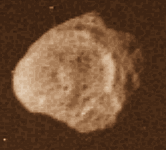
The Voyager 2 image showed Hyperion as a irregular looking blob of rock. Nothing really spectacular looking about it.
As Voyager 2 was simply doing a fly by and had dates with Uranus and Neptune, it was not able to capture better images of this moon.
Then, after the arrival of Cassini at Saturn, who's mission it was to orbit and study both Saturn and it's moons, so that in 2005, the Cassini probe was able to capture this image of Hyperion:
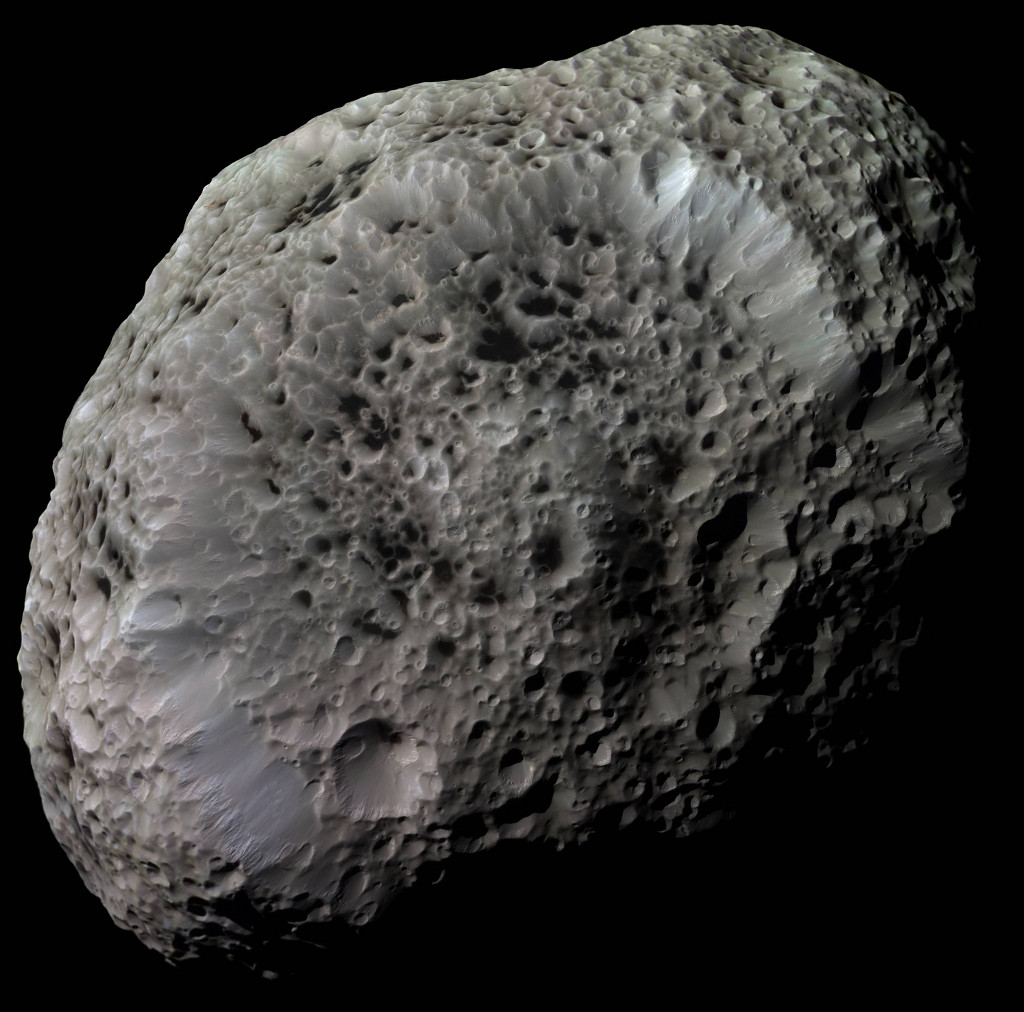
Turns out Hyperion isn't just some irregular blob of a rock after all!
When I first saw this image of Hyperion, I made it my desktop wall paper. I was so impressed with how it looked. All I could think of was:
"Is it a Sea Sponge?"

"Or is it some sort of interplanetary wasp nest?"
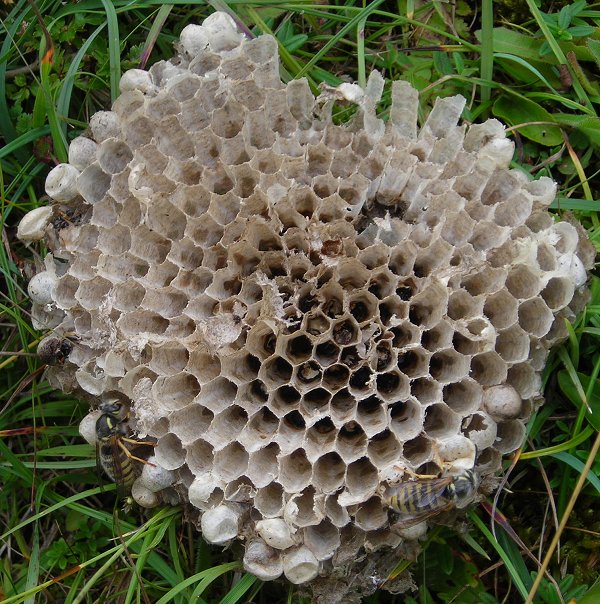
Well, okay, I knew it most likely was not either of those things. Still, the way Hyperion looks it certainly reminded me of those things!
Here is another smaller picture of it, from a different angle and further away:
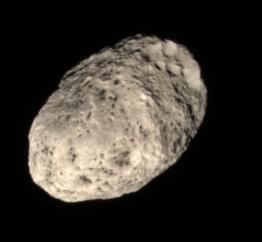
As you can see, when we get further away from it, it doesn't look quite as strange as it does up close and personal.
From what we can tell, Hyperion has a low density indicating that it's made mostly of water ice with a small amount of rock in it.
Cassini flybys of Hyperion helped gather data that seems to show that 40 percent of the moon is empty space.
*imagine the sound of back ground music suddenly screeching to a halt*
Say whaaaaaaat? 40 percent of this moon is "empty space"?????
Okay, before anyone get's REALLY imaginitive here and starts thinking "Hollow Moon!", the data doesn't indicate that there is a large space inside Hyperion that is empty and taking up 40% of the moon's interior.
40 percent empty simply means that there are voids and spaces in the rocky material inside Hyperion. Sort of like if you went outside, got a clear jar and filled it with rocks. If you look at the jar after doing that, you will see spaces inbetween the rocks.
What intrigues me is the water ice itself. It's the reason we have these very deep and sharp craters on the surface of Hyperion.
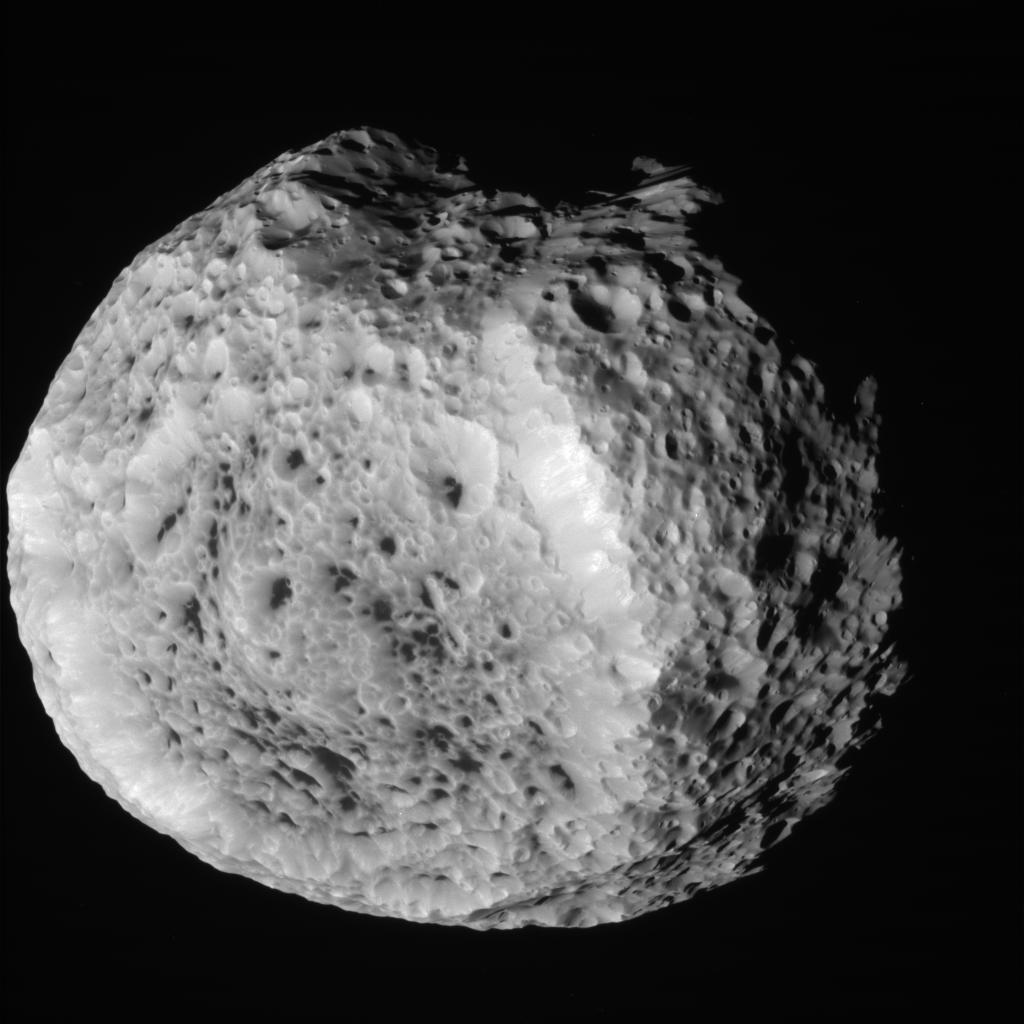
Want to make your own "Hyperion Moon" ? Wait until the next time you have access to snow. Get a hand full of small rocks and glue them together with some super glue, into a rough sphere (this simulates the rocks that are globbed together in Hyperion).
Now take your Rock Glob and hit the snow. roll it around in the snow so that the snow sticks to and begins to accumulate on your Rock glob and until it's completely covered.
Now use your fingers and start poking holes into that rocky snow ball you just made. Make some craters shallow, and make some deep.
If you REALLY want to be authentic, use a sling shot and some dry dog food as small "asteroids" that "impact" with Hyperion.
Then take a picture of it and post it here. I wanna see if anyone actually makes a Hyperion!
Exploring Hyperion with a high resolution picture shows us some impressive looking terrain. I'm wondering if there is ANY level place on the the moon:
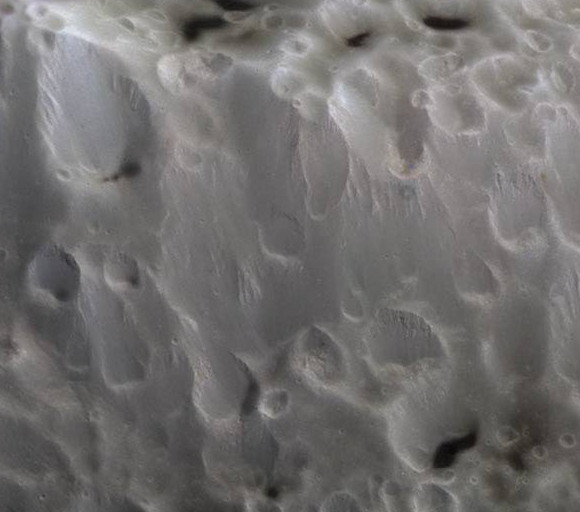
You can just see avalanchies of material that have cascaded down into the craters, reminding me of the Alps:

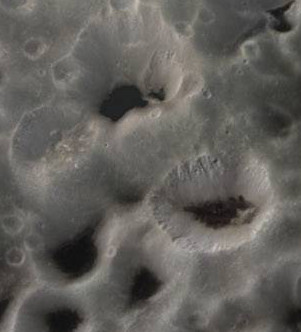
Hyperion has sister moons: Phoebe and Iapetus. Neither of which actually look like Hyperion. Here is a image of Phoebe, it really does look like just a lump of irregular rock:

All though I have heard some say that Phoebe reminds them of some giant "Space Skull"......I don't quite see that one myself.
Iapetus I will show and talk about in another thread.
Other than just simply looking like a giant sea sponge, I've never found anything on Hyperion that suggests something strange (IE secret bases, crashed star ships, etc), however, here is a link where you can download very high resolution images of Hyperion and look for yourself if you wish to:
Hyperion High Resolution Link
Here also is a link to a site that has a very impressive animated GIF of Casinni's 2005 flyby of Hyperion:
FOSS Planetary Science
Hope you enjoyed the thread. Next one will be on Mimas (aka known as the Death Star Moon).
Awesome - i eagerly await more in this series, best thing here in ages imo
Great work OP s+f, my favourite is always going to be Phobos with it's many mysteries and odd shape
reply to post by eriktheawful
Excellent thread. All of that water ice on Hyperion - I could imagine it being a sort of refueling station for manned exploration of the outer solar system and beyond. Because it's small with no presumably no atmosphere, it's unlikely to harbour any kind of life, so I could imagine it being a more attractive prospect for that kind of venture than a place like Europa with all of its ice and liquid water.
Excellent thread. All of that water ice on Hyperion - I could imagine it being a sort of refueling station for manned exploration of the outer solar system and beyond. Because it's small with no presumably no atmosphere, it's unlikely to harbour any kind of life, so I could imagine it being a more attractive prospect for that kind of venture than a place like Europa with all of its ice and liquid water.
It is perhaps, the strangest of any moon we have imaged. The peppered surface is absolutely wild with what seems to be craters, but are probably the
result of severe ablation of frozen gasses and water from being closely exposed to the Sun. I firmly believe it is a captured comet.
The problem, obviously, is the speed that comets typically have as they pass from aphelion to perihelion. How would it be possible for a Saturn to pluck this iceball out of it's cometary orbit, and make it a moon, without destoying it, as we saw with what happened to Shoemaker-Levy when Jupiter intervened? Could the rings of Saturn have something to do with it? If it is not a captured comet, how could a small body like that attract so many other asteroids that could do such surface damage? It is truly a mystery that needs to be solved. Cool post OP, S&F.
The problem, obviously, is the speed that comets typically have as they pass from aphelion to perihelion. How would it be possible for a Saturn to pluck this iceball out of it's cometary orbit, and make it a moon, without destoying it, as we saw with what happened to Shoemaker-Levy when Jupiter intervened? Could the rings of Saturn have something to do with it? If it is not a captured comet, how could a small body like that attract so many other asteroids that could do such surface damage? It is truly a mystery that needs to be solved. Cool post OP, S&F.
edit on 23-8-2013 by
charlyv because: content
Good thread, S&F. I haven't seen anything about this moon before, other than a far away image long ago. It looks like a crystal structure with
tubes, maybe an old comet or something that got captured. It almost looks like it was part of something that was created by life, like coral or a
hive. I'm not sure our definition of life is right, I think that we should expand that definition.
Best damn threads I've seen in awhile. Anxiously awaiting the next moon you pick.
Holy Lava Rock Batman !! Well that was my first impression when I saw this picture.. Then I read your explanation and went hmmm.... makes sense.
This series your doing is my new favorite series on ATS ( sorry slayer ) . I was so glad to see you do another one so quickly. Keep up the fascinating threads.
This series your doing is my new favorite series on ATS ( sorry slayer ) . I was so glad to see you do another one so quickly. Keep up the fascinating threads.
Great initial post to the thread. I am looking forward to more discussion on this moon and it's crazy deep gorges. Beautiful.
reply to post by eriktheawful
Excellent series, Erik!
... also, a very nice comparison (sponge) and who can tell what secrets the many moons in our solar system are still hiding from us!? Somebody must have left traces out there. I mean even 'we' did, or didn't we? Anyhow, keep it up and keep 'em comin', very informative thread!
Excellent series, Erik!
... also, a very nice comparison (sponge) and who can tell what secrets the many moons in our solar system are still hiding from us!? Somebody must have left traces out there. I mean even 'we' did, or didn't we? Anyhow, keep it up and keep 'em comin', very informative thread!
edit on 27-8-2013 by jeep3r because: text
A few more recent images, from Sept 2011. Hyperion doesn't look that weird from other angles. But I do wonder what is that dark material at the bottom
of many craters.
False-colour composites using infrared, green, and UV images from saturn.jpl.nasa.gov...

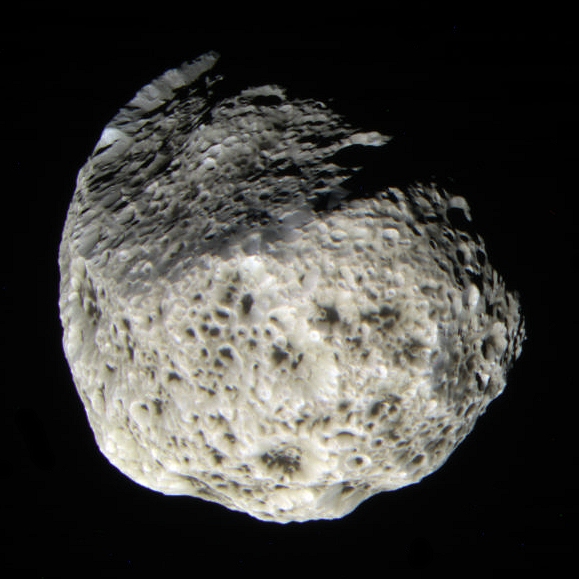
Global mosaic:
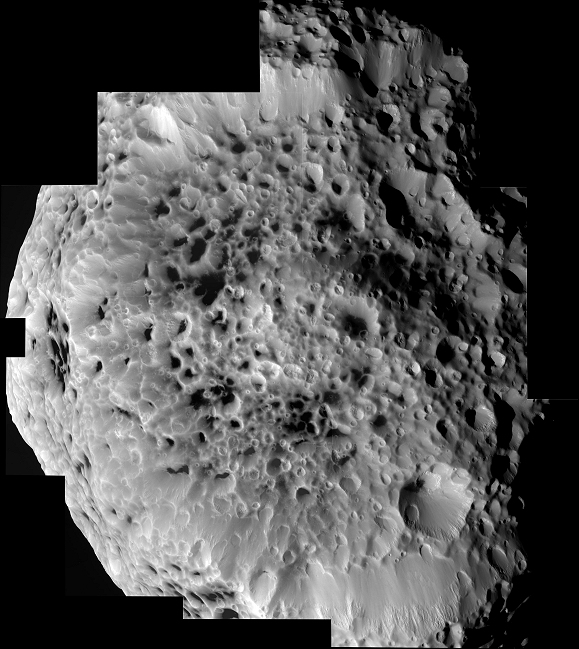
Hi-res version and interactive Photosynth:
www.pictureshack.us...
photosynth.net...
It looks like the "sponge" side of the moon is a giant impact crater, there is even a central peak.
Cross-eyed stereo:
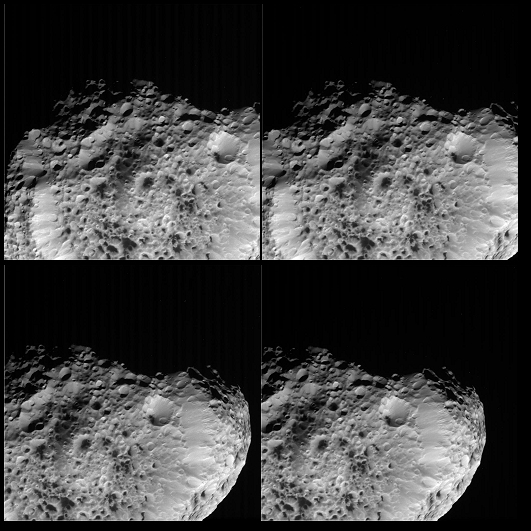
False-colour composites using infrared, green, and UV images from saturn.jpl.nasa.gov...


Global mosaic:

Hi-res version and interactive Photosynth:
www.pictureshack.us...
photosynth.net...
It looks like the "sponge" side of the moon is a giant impact crater, there is even a central peak.
Cross-eyed stereo:

edit on 6-9-2013 by wildespace because: (no reason given)
new topics
-
Any one suspicious of fever promotions events, card only.
The Gray Area: 7 minutes ago -
God's Righteousness is Greater than Our Wrath
Religion, Faith, And Theology: 4 hours ago -
Electrical tricks for saving money
Education and Media: 7 hours ago -
VP's Secret Service agent brawls with other agents at Andrews
Mainstream News: 9 hours ago -
Sunak spinning the sickness figures
Other Current Events: 9 hours ago -
Nearly 70% Of Americans Want Talks To End War In Ukraine
Political Issues: 9 hours ago -
Late Night with the Devil - a really good unusual modern horror film.
Movies: 11 hours ago
top topics
-
VP's Secret Service agent brawls with other agents at Andrews
Mainstream News: 9 hours ago, 9 flags -
Cats Used as Live Bait to Train Ferocious Pitbulls in Illegal NYC Dogfighting
Social Issues and Civil Unrest: 13 hours ago, 8 flags -
Electrical tricks for saving money
Education and Media: 7 hours ago, 4 flags -
HORRIBLE !! Russian Soldier Drinking Own Urine To Survive In Battle
World War Three: 17 hours ago, 3 flags -
Sunak spinning the sickness figures
Other Current Events: 9 hours ago, 3 flags -
Nearly 70% Of Americans Want Talks To End War In Ukraine
Political Issues: 9 hours ago, 3 flags -
Late Night with the Devil - a really good unusual modern horror film.
Movies: 11 hours ago, 2 flags -
The Good News According to Jesus - Episode 1
Religion, Faith, And Theology: 14 hours ago, 1 flags -
God's Righteousness is Greater than Our Wrath
Religion, Faith, And Theology: 4 hours ago, 0 flags -
Any one suspicious of fever promotions events, card only.
The Gray Area: 7 minutes ago, 0 flags
active topics
-
SETI chief says US has no evidence for alien technology. 'And we never have'
Aliens and UFOs • 47 • : andy06shake -
Any one suspicious of fever promotions events, card only.
The Gray Area • 0 • : Cavemannick -
God's Righteousness is Greater than Our Wrath
Religion, Faith, And Theology • 1 • : andy06shake -
Sunak spinning the sickness figures
Other Current Events • 7 • : xWorldxGonexMadx -
HORRIBLE !! Russian Soldier Drinking Own Urine To Survive In Battle
World War Three • 33 • : Degradation33 -
How ageing is" immune deficiency"
Medical Issues & Conspiracies • 34 • : angelchemuel -
Nearly 70% Of Americans Want Talks To End War In Ukraine
Political Issues • 13 • : Freeborn -
Mood Music Part VI
Music • 3101 • : ThatSmellsStrange -
VP's Secret Service agent brawls with other agents at Andrews
Mainstream News • 41 • : ThatSmellsStrange -
New whistleblower Jason Sands speaks on Twitter Spaces last night.
Aliens and UFOs • 55 • : baablacksheep1
36
